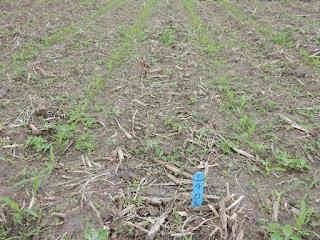By Ryan Miller
Nothing demonstrates the value of a preemergence herbicide quite like a missed postemergence ONLY application. In 2022, we did just that, intentionally. The products we will talk about in this article are for educational purposes only; they are not intended to be an endorsement of success or failure. Many product choices are available and can be adapted to your needs. The full set of 2022 corn weed management data is available, but in this article, we’ll focus on just two: 1) a delayed POST only application, and 2) a PRE followed by a POST.
Corn weed management trial
In treatment 19 of the 2022 corn weed management trial, we intentionally delayed a POST only application of Acuron GT + Atrazine. There are numerous scenarios that could cause a delay in a POST application, and I am sure we have all experienced many of them. Unsuitable weather and field conditions, equipment failures, custom applicator delays and the list could go on...

First things first, let’s look at how weedy things were at the time of our first POST I application. Plots were planted on May 19th, PREs went on May 23rd, the first (POST I) application was on June 9th, the second (POST II) application was June 17th. Photo 1 is of the weedy check on June 7th.
Treatment 4 is an example of a PRE followed by POST I application. It consisted of 36 fl oz/a Acuron Flexi PRE followed by (fb) 36 fl oz/a Acuron Flexi + 32 fl oz/a Roundup PowerMAX. Photo 2 shows what the weeds looked like prior to the POST I application on June 9th.
Treatment 19 is an example of when a POST only application gets delayed. Treatment 19 consisted of a POST II application of 3.75 pt/a of Acuron GT + 16 fl oz/a atrazine. Photo 3 shows what the weeds looked like ahead of the June 17th POST II application.

Photo 2. Treatment 4. PRE 36 fl oz/a Acuron Flexi Photo: June 7th, 2022

Photo 3. Treatment 19. DEMONSTRATION POST ONLY delayed application. June 14th, 2022
The Treatment 19 picture shows the great potential for weed populations to develop when a PRE is not used and the POST application is delayed; at this point there is substantial crop weed competition occurring. Ten days after the POST II application (June 27th), we can see dead weeds in treatment 19 but if you look closely, you can see just how stressed the crop is at this point. We’ve also included photos of the weedy check and Treatment 4 taken on June 27 for comparison:

Weedy check. Photo: June 27, 2022.

Treatment 4. PRE 36 fl oz/a Acuron Flexi fb 36 fl oz/a Acuron Flexi. Photo: June 27 , 2022.

Treatment 19. Delayed POST 3.75 pt/a of Acuron GT + 16 fl oz/a Atrazine. Photo: June 27
If we fast forward to September, we can see additional challenges to a POST only application, particularly when POST applications get delayed. Significant yield penalties did occur as corn is not tolerant to early season weed competition (Table 1).
Table 1. Woolly cupgrass control and corn yields from weed management trial, 2022 (selected treatments).

Means followed by the same letter do not significantly differ (P=0.10, LSD)
*Weed control ratings from the end of season prior to harvest
Soybean weed management trial
Similar things can be said about soybeans and the value of a PRE program. While soybeans tend to be a little more tolerant of early season weeds, this is not always the case as you can see yield penalties from early season weeds on occasion. Adding a PRE can make managing weeds with POST applications much easier. At the POST timing, weed density will be reduced and weed size will be more uniform, making it easier to decide to when to make your POST application, not to mention you will get better efficacy. The take-home message is that PRE’s will give you better, more consistent weed control with your POST applications. In addition, adding multiple effective modes of action can help manage herbicide resistance and herbicide resistant weed populations.
One difference between corn and soybean is that soybeans are slower to canopy and can benefit from having more residual chemistry added to the POST applications. In this case we will look at four treatments: the weedy check, POST only, PRE fb POST with NO residual, PRE fb POST with residual. The PRE and POST treatments are all the same, and the POST residual was a group 15. Photos are from 8 weeks after planting/PRE (WAP).

Table 2. Lambsquarter and woolly cupgrass control and soybean yields from weed management trial, 2022 (selected treatments).

Means followed by same letter do not significantly differ (P= 0.10, LSD)
*Weed control ratings from the end of season prior to harvest
As it turns out in our 2022 soybean weed management trial, to maximize weed control we needed to utilize one of a select few PRE fb POST with residual treatments or we needed a PRE followed by two POST applications. We will share full results when available.
Source : umn.edu